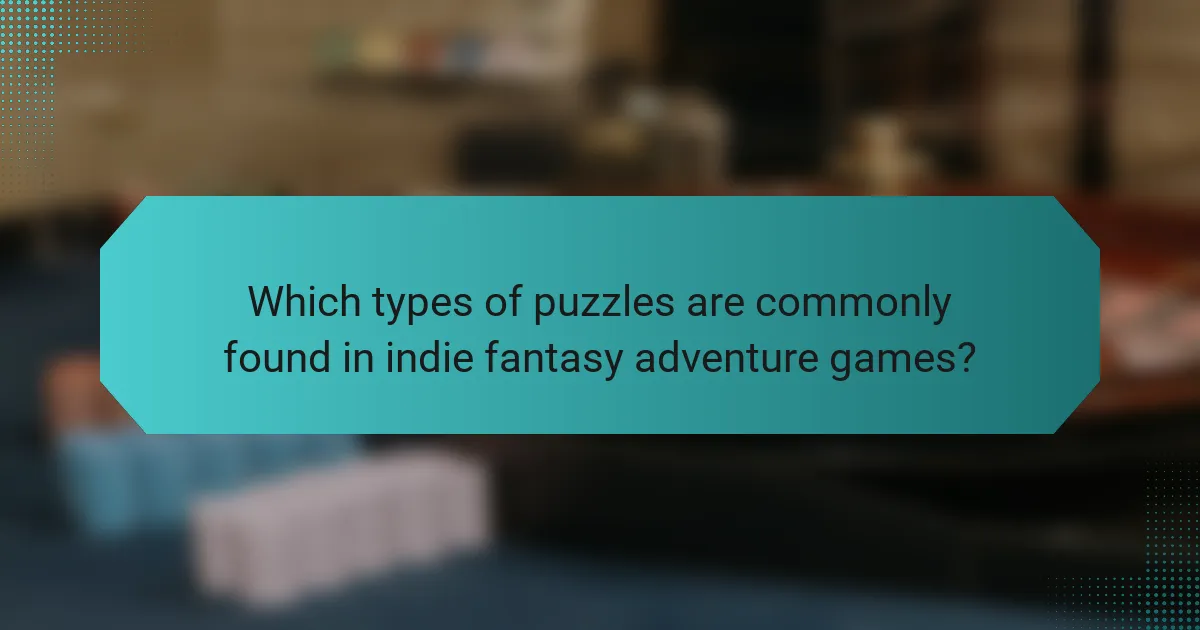Puzzle mechanics in indie fantasy adventure games present unique challenges and opportunities for developers and players alike. This article explores various types of puzzles, including environmental and logic puzzles, while addressing design challenges like balancing difficulty and maintaining narrative coherence. It also highlights innovative solutions such as adaptive difficulty and procedural generation that enhance player engagement. Finally, we discuss future trends that promise to further enrich the puzzle experience in indie games.

What are the key characteristics of puzzle mechanics in indie fantasy adventure games?
Puzzle mechanics in indie fantasy adventure games often feature creativity, engagement, and variety. Key characteristics include environmental interactions, narrative integration, and escalating difficulty. Environmental interactions allow players to manipulate objects and elements within the game world, enhancing immersion. Narrative integration connects puzzles to the storyline, making them relevant to the player’s journey. Escalating difficulty ensures that puzzles challenge players progressively, maintaining engagement and satisfaction as they advance. Unique attributes, such as time-based puzzles or character-specific challenges, can further differentiate gameplay experiences.
How do puzzle mechanics enhance gameplay experience?
Puzzle mechanics significantly enhance gameplay experience by fostering engagement and critical thinking. These mechanics create challenges that encourage players to explore, strategize, and interact with the game world.
Types of puzzle mechanics include logic puzzles, environmental puzzles, and pattern recognition challenges. Each type demands different cognitive skills, keeping gameplay fresh and stimulating. For example, logic puzzles often require deductive reasoning, while environmental puzzles encourage spatial awareness.
Challenges presented by puzzles can vary in complexity, affecting player satisfaction. Well-designed puzzles balance difficulty, ensuring players feel accomplished upon solving them. This balance prevents frustration and promotes a sense of progression.
Solutions to puzzles often involve clues embedded within the game environment. Players must pay attention to details, enhancing immersion. This interplay between observation and problem-solving deepens the overall narrative experience, making puzzles integral to gameplay in indie fantasy adventure games.
What role does narrative play in puzzle design?
Narrative plays a crucial role in puzzle design by enhancing player engagement and immersion. A well-crafted story provides context for puzzles, making them feel meaningful within the game world. It can guide players through challenges, offering clues that align with the narrative. Additionally, narrative elements can create emotional stakes, motivating players to solve puzzles to progress the story. This integration of storytelling and gameplay fosters a deeper connection between players and the game, enriching the overall experience.

Which types of puzzles are commonly found in indie fantasy adventure games?
Indie fantasy adventure games commonly feature various puzzle types, enhancing gameplay and immersion. These include environmental puzzles, logic puzzles, inventory puzzles, and riddles. Environmental puzzles often require players to manipulate objects within the game world to progress. Logic puzzles challenge players to think critically, often involving pattern recognition or sequence solving. Inventory puzzles necessitate combining or using items creatively to overcome obstacles. Riddles typically engage players with wordplay or clues that must be deciphered to advance the story. Each type offers unique challenges that contribute to the overall gaming experience.
How do environmental puzzles differ from logic puzzles?
Environmental puzzles focus on the interaction with surroundings, while logic puzzles emphasize reasoning and deduction. Environmental puzzles often require players to manipulate objects or navigate spaces, integrating them into gameplay. In contrast, logic puzzles present scenarios demanding analytical thinking, often through riddles or sequences. This distinction highlights the mechanics that enhance player engagement in indie fantasy adventure games.
What are the unique features of narrative-driven puzzles?
Narrative-driven puzzles feature immersive storytelling, character development, and emotional engagement. These puzzles often integrate plot elements, enhancing player investment in the game. Unique attributes include context-sensitive clues that relate to character backstories and environments, fostering deeper connections. Additionally, they challenge players with non-linear solutions, encouraging creative thinking and exploration.
How do collectible puzzles engage players?
Collectible puzzles engage players by offering interactive problem-solving experiences that enhance gameplay. They provide unique challenges, encourage exploration, and promote collaboration among players. Collectible puzzles often include distinct themes, rewarding players with valuable in-game items or story progression upon completion. As a result, they deepen player immersion and satisfaction in indie fantasy adventure games.

What challenges do developers face when designing puzzle mechanics?
Developers face several challenges when designing puzzle mechanics, including balancing difficulty, ensuring player engagement, and maintaining narrative coherence. Balancing difficulty is crucial; puzzles must be challenging yet solvable to avoid player frustration. Engagement is vital; puzzles should feel rewarding and integrated into gameplay. Narrative coherence ensures puzzles enhance the story rather than detract from it, creating a seamless experience. Additionally, developers must consider player diversity in skill levels, requiring varied puzzle types to cater to different audiences.
How can puzzle difficulty impact player retention?
Puzzle difficulty significantly influences player retention in indie fantasy adventure games. Players are more likely to stay engaged when puzzles are challenging yet solvable, striking a balance that fosters satisfaction. Too easy puzzles may lead to boredom, while overly difficult ones can result in frustration. Effective puzzle design incorporates gradual difficulty progression, allowing players to build skills and confidence. This approach enhances the gaming experience, promoting longer play sessions and increased player loyalty.
What are common pitfalls in puzzle design?
Common pitfalls in puzzle design include lack of clarity, overcomplexity, and insufficient feedback. Clear objectives are crucial; players must understand what to do. Overly intricate puzzles can frustrate players, leading to disengagement. Providing timely feedback helps players gauge their progress and adjust their strategies effectively. Balancing challenge and accessibility ensures a rewarding experience without overwhelming the player.
How do cultural differences influence puzzle design and player expectations?
Cultural differences significantly shape puzzle design and player expectations in indie fantasy adventure games. Designers must consider cultural contexts to create engaging experiences that resonate with diverse audiences.
For example, puzzle mechanics may incorporate local myths or folklore, affecting how challenges are structured. Cultural symbols and colours can also influence player perception and emotional responses.
Player expectations vary based on cultural backgrounds; some players may prefer straightforward challenges, while others enjoy complex, layered puzzles. Understanding these nuances helps developers tailor experiences that meet varied preferences.
As a result, successful puzzle design in this genre requires a deep understanding of cultural diversity, ensuring that puzzles are not only entertaining but also culturally relevant.

Which innovative solutions have emerged to enhance puzzle mechanics?
Innovative solutions enhancing puzzle mechanics include adaptive difficulty, environmental storytelling, and procedural generation. These methods create dynamic gameplay, engage players, and offer unique challenges. Adaptive difficulty adjusts puzzles based on player performance, ensuring a balanced experience. Environmental storytelling integrates narrative elements into puzzles, deepening immersion. Procedural generation introduces variability, keeping puzzles fresh and unpredictable.
How can technology improve puzzle interactivity?
Technology enhances puzzle interactivity by integrating dynamic elements, real-time feedback, and adaptive difficulty. These features create immersive experiences that engage players more deeply.
Dynamic elements, such as animated graphics and sound effects, enrich the puzzle-solving experience. Real-time feedback, including hints or visual cues, allows players to adjust their strategies instantly. Adaptive difficulty ensures challenges match player skill levels, maintaining engagement without frustration.
Incorporating multiplayer features fosters collaboration, allowing players to solve puzzles together, enhancing social interaction. Additionally, utilizing augmented reality can create a more immersive environment, merging the game world with the real world.
These technological advancements not only improve engagement but also encourage creativity and critical thinking, essential for the success of indie fantasy adventure games.
What role does player feedback play in refining puzzles?
Player feedback is crucial for refining puzzles in indie fantasy adventure games. It helps developers identify challenges players face and adjust difficulty levels accordingly. Engaging players through feedback allows for the discovery of unique attributes in puzzle mechanics, enhancing the overall gameplay experience. Moreover, player insights can reveal rare attributes that may not have been initially considered, leading to innovative solutions and improved puzzle design.

How do indie developers approach puzzle mechanics differently than larger studios?
Indie developers often prioritize innovative and unique puzzle mechanics, in contrast to larger studios that may rely on established formulas. They embrace creativity and experimentation, allowing for diverse gameplay experiences. Indie games frequently incorporate narrative-driven puzzles that enhance emotional engagement, while larger studios may focus more on broad appeal and market trends. Additionally, indie developers often face resource constraints, leading them to create simpler yet more profound puzzles that challenge players in unexpected ways. This approach fosters a distinctive identity within the indie gaming landscape, emphasizing originality and player connection.
What are the benefits of unique puzzle mechanics in indie games?
Unique puzzle mechanics in indie games enhance player engagement and creativity. They encourage critical thinking, foster exploration, and provide a sense of accomplishment. These mechanics often introduce innovative challenges that differentiate the gameplay experience from mainstream titles. For example, using environmental puzzles can create immersive narratives that deepen the player’s connection to the game world.
How does budget impact puzzle design choices?
Budget significantly influences puzzle design choices by limiting resources, impacting creativity, and shaping complexity. Lower budgets often lead to simpler mechanics and fewer unique attributes, while higher budgets allow for intricate designs and diverse challenges. Additionally, budget constraints may prioritize core gameplay elements over elaborate puzzle features. Developers often adapt by focusing on innovative solutions within their financial limits, ensuring engaging experiences despite limitations.

What are the future trends in puzzle mechanics for indie fantasy adventure games?
Future trends in puzzle mechanics for indie fantasy adventure games include greater integration of narrative elements, enhanced player agency, and the use of procedural generation. Developers are focusing on creating puzzles that not only challenge players but also deepen the storytelling experience. For example, puzzles that adapt based on player choices can lead to unique solutions and outcomes, enhancing replayability. Additionally, incorporating technology such as augmented reality may provide immersive puzzle experiences that blend the physical and virtual worlds. As a result, indie games will likely continue to innovate in puzzle design, prioritising player engagement and narrative depth.
How might AI influence puzzle design in the coming years?
AI will significantly enhance puzzle design in indie fantasy adventure games by introducing adaptive mechanics and personalized challenges. These innovations will create dynamic gameplay experiences tailored to individual player skills. AI can analyze player behavior, adjusting puzzle complexity in real-time to maintain engagement. As a result, puzzles will evolve from static challenges to interactive experiences that respond to player choices. This shift will lead to more immersive narratives and deeper player investment in game worlds.
What are the implications of cross-platform puzzle mechanics?
Cross-platform puzzle mechanics enhance player engagement and accessibility across devices. They allow seamless gameplay experiences, fostering community interaction and diverse problem-solving approaches. This inclusivity broadens audience reach, encouraging innovation in puzzle design and gameplay strategies.
What best practices should developers follow when creating engaging puzzles?
Developers should focus on clarity, challenge, and feedback when creating engaging puzzles. Clear objectives help players understand goals. Challenges should escalate in difficulty, promoting skill development. Immediate feedback on player actions enhances engagement and learning. Incorporating diverse mechanics, such as logic, pattern recognition, and exploration, keeps puzzles fresh and stimulating.